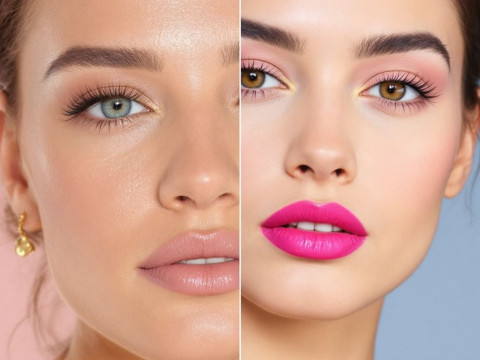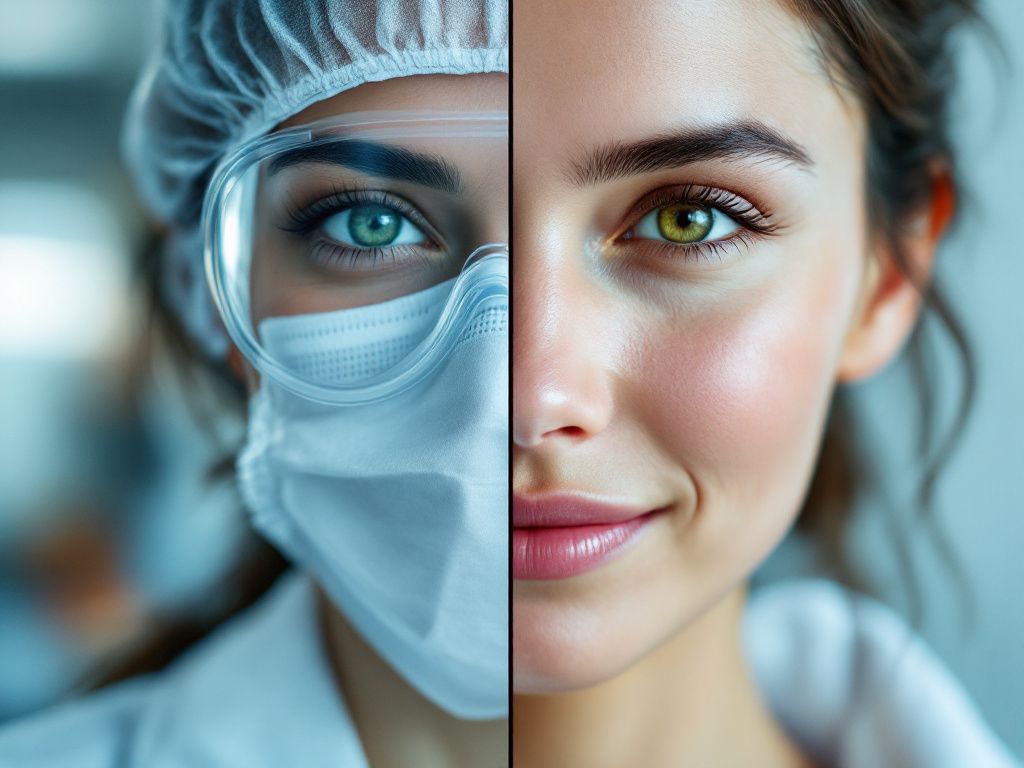Hey there, Lab Techs! Got a minute for your skin’s sake? Navigating the complexities of the lab environment while keeping your skin healthy can feel like juggling while riding a unicycle—it’s wildly challenging and might lead to a few mishaps. Have you noticed that constant exposure to chemicals and long hours among test tubes cause work acne and other skin issues? Trust me, you’re not alone. Lab life is exhilarating, for sure, but it can also be harsh on your skin.
Understanding the Lab Environment Skin Conundrum
Let’s chat about the lab environment and its impact on our skin. Working under stringent conditions—where gloves, masks, and goggles are part of your uniform—brings its share of skin woes. Chemicals, despite all precautions, can’t help but poke their toxic little noses into your life, causing irritation or even worse—persistent acne. And let’s not even start with stress as the silent accomplice working behind the scenes, catalyzing breakouts like it’s their part-time gig.
Why Does Lab Work Cause Acne?
Before we dive into the “how-tos,” let’s break down why exactly lab work can lead to acne. Quick science lesson: your skin has oils, bacteria, and dirt. Mixing them up in abnormal doses is a recipe for acne. In a lab environment, you’re often in gear that doesn’t allow your skin to breathe. Gloves trap the sweat, masks clinch to your face, and bam!—your skin is clamoring for air. Not to mention the soap you use (S/O to harsh detergents) can dry your skin, pushing it to produce even more oil, creating—yep, you guessed it—acne.
Skin Protection Essentials for Lab Technicians
So what’s the game plan, right? How do you defend your skin from the lab’s minor villains? Here are a few tips that might become your skincare anthem by the end!

Mind Your PPE
Let’s talk about that daily sidekick—Personal Protective Equipment. Nothing says “I’m a Scientist” like a snug pair of gloves and a trusty mask. While they’re there for safety, they might play foul with your skin. It’s crucial to ensure your PPE fits well but doesn’t suffocate your skin more than it needs to. This tiny adjustment can do wonders.
- Gloves: Opt for latex-free, breathable gloves when possible. Too tight, and they block air circulation. Too loose, and they can cause friction that irritates the skin.
- Masks: Choose those made with softer material that’s gentle on the skin. Pro Tip—switch them out regularly to keep things fresh!
Clean Skin is Happy Skin
Oh, didn’t this one surprise you? Let’s face reality: having clear skin is rooted in consistent cleansing, so don’t skimp out here.
- Start Your Shift Right: Cleansing your face with a gentle wash before and after your shift is crucial. Look for products labeled non-comedogenic (it’s a fancy way to say they won’t clog your pores) and fragrance-free.
- Moisturize, Moisturize, Moisturize: A good moisturizer works wonders. It keeps the hydration in and forms a barrier against the madness that is lab air. Look for lightweight, oil-free options.
Hydration Meets Protection
Later on, we’ll get to finding balance—because balance makes or breaks skin care—but first, hydration.
- Drink Water (Seriously, Drink It): We all hear this a thousand times a day, but hydration needs to happen from the inside-out. Keep that water bottle close like your favorite lab tool.
- Humidity and Your Lab: If your lab environment is extremely dry, toss a small humidifier in your workspace if that’s doable. Humidifying helps prevent that parched-skin look we all hate.
Common Mistakes in Lab Technician Skin Care

I’m not calling anyone out, but some easily-missed habits could be the undercover agents in your skin’s frustrating saga.
- Using Abrasive Cleaning Products: Let those harsh cleaners work on your instruments, not your face. Overly aggressive scrubbing products can anger sensitive skin.
- Neglecting Sunscreen: Yes, sunscreen, even inside. Labs have lighting that may contribute to skin stress, and sunscreen helps keep irritation at bay. Sunscreen should be part of your daily routine quicker than lab coat buttons.
- Ignoring Allergic Reactions: If you notice persistent redness or acne due to an allergy to any gear or chemical, assess alternatives immediately.
Skincare Rituals to Embrace
Trust me, a smart skincare regime feels as satisfying as completing a flawless titration. It’s about strategic choices folded into habits that won’t quicken your morning rush one bit.
The Morning Boost
- Gentle Cleanser: Start your day with a burst of freshness by using a gentle, soothing facial cleanser.
- Top-Tier Serum: Picking a serum rich in antioxidants not only preps your skin but also stands guard against free radicals galore.
- Moisturizer Savior: Don’t forget that generous application of a hydrating, light moisturizer to lock all that goodness in.
Wind Down Right

- Makeup’s Gotta Go: If you wear makeup, make sure it’s wiped off fully to avoid clogging those pores you’ll regret later.
- Night Renewal Cream: Granted it doesn’t have to be the fanciest one, but a night cream can work miracles, helping your skin refresh and renew post-stressful lab hours.
Balancing Act: Skin, Stress, and You
Balancing life, work acne stress, and your commitments is no easy job. But finding breathers can help manage stress-related skin flare-ups.
- Breaks and Breaths: Take those small micro-breaks to step outside—even if for a few seconds to inhale, exhale, and light up another perspective.
- Mind Your Tuesday Thoughts: Easier said than done, but maintain boundary lines between work and home life to keep sudden stress impacts minimal.
Key Takeaways
Alright, let’s bundle everything up into concise memories:
- Keep it Gentle: A gentle routine and fitting gear can dictate your work acne outcomes.
- Moisturize with Care: Balanced hydration forms the crux of lovely skin.
- Know Your Skin: Understand what agrees with your skin and fine-tune from there.
- Stress Management: Jump into boundary settings for that seamless ‘me-time.”
Whether it seems huge or trivial initially, every tiny skin-care step matters massively in a laboratory universe, brightened by the wonders of chemistry and shielded against acne battles. Start integrating these defenses to lap belts of skin’s fierceness unanticipated, while donning lab coats like pros yee-oh-self go(rep). Ready, set, embrace dissatisfaction-free scientific days my lovely fellas!
Frequently Asked Questions
What causes acne?
Acne is caused when hair follicles become blocked with oils, dead skin cells, and bacteria. The sebaceous glands produce sebum, an oily substance, which can be stimulated by hormones such as testosterone, leading to excess sebum production. This excess sebum, combined with dead skin cells, clogs the hair follicles. Bacteria like *Cutibacterium acnes* can then infect these clogged follicles, causing inflammation and acne symptoms[1][3][5>.
What are the common symptoms of acne?
The symptoms of acne include blackheads, whiteheads, inflamed red bumps (papules), bumps with pus (pustules), painful bumps under the skin (cysts or nodules), and post-inflammatory hyperpigmentation. These symptoms can occur primarily on the face, neck, shoulders, chest, and upper back. The affected areas may be tender or painful[1][3][5>.
Can diet and lifestyle factors influence acne?
Yes, diet and lifestyle factors can influence acne. High glycemic load diets, consumption of cow’s milk, particularly skim milk, and certain medications can contribute to the development or worsening of acne. Additionally, stress, smoking, and certain skin care products can exacerbate acne symptoms[1][3][5>.
Is acne hereditary, and can it be triggered by other medical conditions?
Acne can run in families, with individuals having a family history of acne being more likely to develop it. Certain medical conditions such as polycystic ovary syndrome, congenital adrenal hyperplasia, and other endocrine disorders can also trigger acne due to hormonal imbalances[1][3][5>.
References










